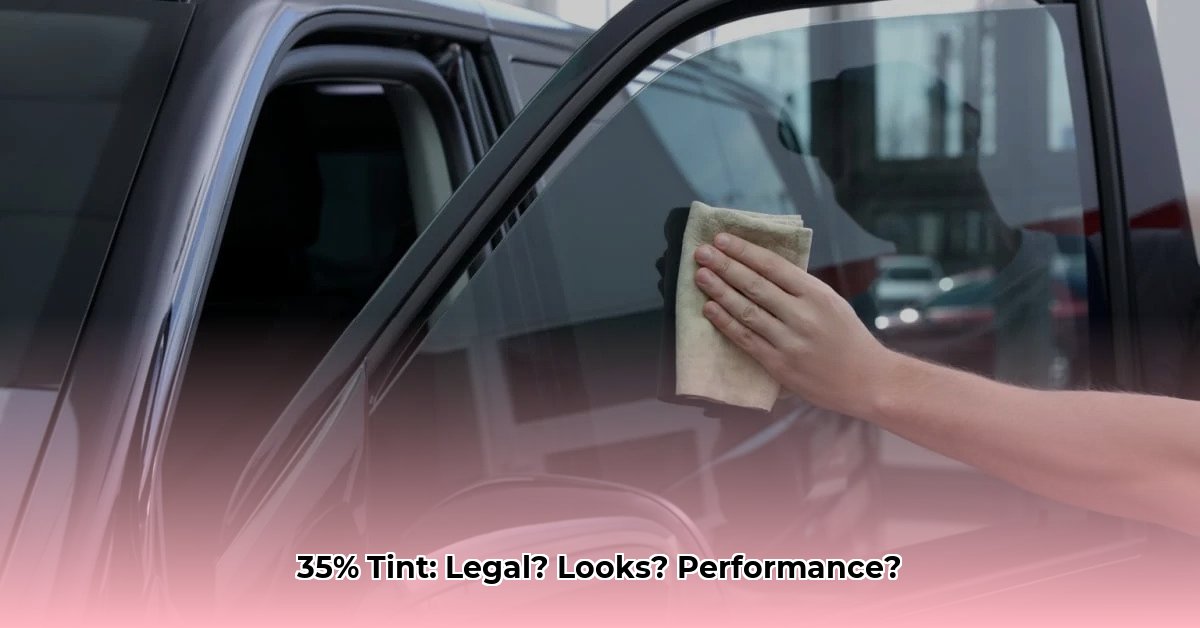Thinking about 35% tint for your car? This guide covers everything you need to know, from understanding VLT and legality to the pros, cons, and even finding a reputable installer.
Decoding 35% Tint: What Does it Mean?
“35% VLT” refers to Visible Light Transmission. This means 35% of visible light passes through the tinted window, while 65% is blocked. It’s like sunglasses for your car—offering a balance between shade and visibility.
Is 35% Tint Legal in My Area?
Tint laws vary significantly by state and even locally. While 35% might be legal for rear windows in one area, it could be illegal for front windows in another. Always check with your local Department of Motor Vehicles (DMV) or law enforcement. Resources like the International Window Film Association (https://iwfa.com/) may offer general guidance, but always defer to local authorities.
Visualizing 35% Tint: What Does it Look Like?
35% tint offers a noticeable difference from factory tint or clear glass, providing a sleek aesthetic. It enhances privacy and reduces glare without being excessively dark. The perceived darkness can be influenced by your car’s interior color and exterior lighting conditions. Searching online for images of cars with 35% tint, especially models similar to yours, can give you a better visual understanding.
Benefits of 35% Tint: More Than Just Looks
Beyond aesthetics, 35% tint offers several advantages:
- Glare Reduction: Improves driving comfort, especially on sunny days.
- Heat Rejection: Keeps your car cooler, reducing strain on your A/C.
- UV Protection: Shields your car’s interior from fading and protects your skin.
- Enhanced Privacy: Deters prying eyes and adds a sense of security.
Potential Drawbacks of 35% Tint
While 35% tint offers numerous benefits, consider these potential drawbacks:
- Reduced Night Visibility: Can make driving in low-light conditions more challenging. This effect is amplified in rain or fog.
- Backup Camera Interference: Some drivers report minor visibility issues when using backup cameras at night. This likely varies depending on the camera’s quality and lighting conditions.
How Much Does 35% Tint Cost?
The cost of 35% tint varies depending on factors like:
- Vehicle Size: Larger vehicles require more film.
- Film Type: Ceramic tints are typically more expensive than dyed films.
- Installer: Labor rates vary.
Always get quotes from multiple reputable installers to compare prices and services. Don’t solely focus on price; quality installation is crucial.
Professional Installation vs. DIY
While DIY kits exist, professional installation is highly recommended. Professionals have the expertise and tools to ensure a flawless, bubble-free finish and avoid potential legal issues from improper installation.
Comparing Tint Percentages
| Tint Percentage | Light Transmission | Appearance | Heat Rejection | Privacy | Night Visibility |
|---|---|---|---|---|---|
| 50% | Higher | Lighter | Less | Less | Best |
| 35% | Moderate | Moderate | Moderate | Moderate | Moderate |
| 20% | Lower | Darker | More | More | Reduced |
| 5% | Very Low | Very Dark (Limo Tint) | Most | Most | Significantly Reduced |
This table provides a general comparison. Actual performance can vary based on film quality and other factors.
35% Tint and Night Driving: Is it Safe?
While 35% tint is generally safe for night driving, it requires adjustments:
- Reduce Speed: Especially in poorly lit areas.
- Increase Following Distance: Allow more reaction time.
- Use High Beams Strategically: When appropriate and safe for oncoming traffic.
If you frequently drive at night in poorly lit areas, consider a lighter tint or high-quality ceramic film known for better clarity. Some research suggests that even lighter tints can provide substantial heat and UV protection.
Finding a Reputable Tint Installer
Choosing the right installer is critical. Look for:
- Experience: Ask about their experience and specialization in window tinting.
- Reviews: Check online reviews for feedback on quality and customer service.
- Warranty: Inquire about warranties on the film and installation.
- Film Quality: Ensure they use high-quality films from reputable manufacturers.
Is 35% Tint Right For You?
Consider these factors when deciding:
- Local Laws: Ensure compliance with regulations in your area.
- Driving Habits: Think about your typical driving conditions, including nighttime and bad weather driving.
- Desired Privacy Level: Balance privacy with visibility needs.
- Budget: Factor in the cost of film and installation.
By carefully weighing these aspects, you can confidently determine if 35% tint is the best fit for your car and driving style.
Disclaimer: This information is for informational purposes only and not legal advice. Always verify tint regulations with your local authorities.
- Dora the Explorer Wipe-Off Fun: Safe & Mess-Free Activities for Little Explorers - April 18, 2025
- Does Lemongrass Repel Mosquitoes? Fact vs. Fiction + How to Use It - April 18, 2025
- Do Woodchucks Climb Trees?Fact vs. Fiction - April 18, 2025










